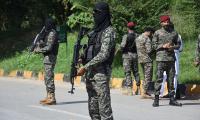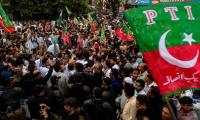A hot shower is now a luxury in Pakistan. The new gas tariff is hurting not only consumers but the government as well. The media is asking tough questions from the government and the government is visibly disturbed. Like always, the elephant of seventy percent less well-off Pakistanis remains invisible and a government is being attacked for finally doing something right.
No government has ever been hurt by the fact that piped gas has been made available to less than one third citizens, favouring the most prosperous sections of society and geographical areas. The remaining seventy percent cook using open fires or simple stoves fuelled by kerosene, biomass (wood, animal dung and crop waste) and firewood.
According to WHO, each year close to four million people die worldwide prematurely from illness attributable to household air pollution from inefficient cooking practices. We can safely assume that thousands of such deaths occur in Pakistan. Pneumonia is a major killer of children under five years of age. Close to half of these deaths are caused by particulate matter (soot) inhaled from household air pollution.
Household air pollution causes a number of diseases including stroke, heart disease and lung cancer. Again, we can safely assume that hundreds of thousands of Pakistanis get these medical problems each year because no clean fuel is available to them.
The government has ended some subsidy on natural gas and is perhaps also forcing consumers to pay for the gas stolen by other consumers. These steps have been taken without a well-thought-out policy about government subsidies. In the same breath, the government has allowed CNG, fertilizer and textiles, three crony sectors of Pakistan’s economy to gobble up Rs200 billion of gas infrastructure development cess, duly paid by consumers and collected by these sectors.
The real scandal is not lifting subsidies to some extent, but how natural gas has been susbsidised in Pakistan for the last seven decades since the Sui gas field became operational in the mid-1950s. The Sui gas field in the Bugti tribal area meets approximately 45 percent of the country’s total gas production. The Dera Bugti district, where the gas fields are located, is amongst the least developed areas in the country. Balochistan itself did not benefit much from its natural treasures. The royalty fixed for gas drawn from the field area is based on ‘wellhead value’, which remained extremely low till recently.
Though natural gas was discovered in Balochistan in 1952, many districts of the province remain deprived of gas transmission facilities. It was only in 1976 that the province got liquefied petroleum gas (LPG) in Quetta. Later, gas through pipelines was made available in the city. The situation in Sindh’s gas-producing districts is not much different either.
While laying pipelines for distributing gas, the less well-off areas were discriminated everywhere For example, almost every village in central Punjab has piped gas, while in southern Punjab most secondary cities are without this facility. In fact, many large cities in the region were connected with gas pipelines very recently.
These huge subsidies mean that resources were transferred from the gas-producing regions – which happen to be the poorest in the country – to the gas-consuming regions, which are the most well-off.
Let the short months of winter pass by and every gas consumer, few of them below the poverty line, will spend less on gas for cooking than their domestic workers pay for their firewood. The current system of subsidy assumes that those who consume less gas are poor and need to be subsidised while those who consume more are rich and should pay more. It ignores the fact that people with less income often have large families or live in combined families while well-off people often live in nuclear families with a smaller number of children. It is a very lazy style of providing subsidy on a precious natural resource.
While acting to lower subsidies on natural gas, the government has failed to plug leakages in the system of distribution of utilities, particularly gas and electricity. The theft of these two utilities remains rampant. Since both utilities belong to the federation, provinces show little interest in cooperating with distributing companies to stop the theft. In some cases, like the PTI government in Khyber Pakhtunkhwa during the last tenure at least, the provincial government actively supports theft of utilities.
It has been estimated that total energy system losses amount to $2,168 million per year, of which electrical system losses are $1,400 million and gas system losses are $768 million. A good part of these losses are related to theft and corruption. Such theft is hurting the national economy hard as is clear from the fast piling up circular debt. It also makes a mockery of lifting subsidies and forcing honest consumers to pay the full cost of utilities.
The government should rethink and revamp the whole system of subsidies and stop supporting the rich at the cost of the poor. Such support becomes ridiculous when it is done in the name of the poor.
Take the example of the Utility Stores Corporation through which the government subsidises selected food items. Almost all of the stores are located in well-off areas of cities and are mostly frequented by middle-class consumers to make some savings. Instead of keeping this charade of subsiding food for people, the government should either close them down or redefine their role. It will be more suitable to use these resources to support charities that try to feed the hungry and provide food support to the poor.
Hassan Khawar, a public policy expert, has calculated that out of the total development spending of Rs1.7 trillion in Punjab during the last five years, a massive 50 percent or Rs853 billion were spent in Lahore. On a per capita basis, the province spent 25-30 times more on a citizen of Lahore than a citizen of Layyah, Pakpattan or Chiniot.
Something similar, though less in scale, was done by the KP government during the same period. According to research done by the Omar Asghar Khan Foundation, a leading civil society organisation working in KP, the sum allocated to three districts of Nowshehra, Swat and Swabi was Rs58.13 billion, 47 percent more than the total development funds of Rs30.78 billion given to the province’s seven chronically poor southern districts. The six districts of Hazara received Rs33.26 billion or 42 percent less than amounts given to the three favourite districts.
The bias towards tertiary education and tertiary healthcare system is another way of supporting the rich at the cost of the poor. The government either subsidises or fully pays for the higher education of middle-class children while ignoring primary education for poor children. It keeps distributing laptops to middle-class students while primary schools have been deprived of very basic necessities like drinking water and toilets.
After years, I have become alert to the gas burning in my wasteful geyser. I have also learnt that a cold shower can be great for health. However, Naya Pakistan must be more than the magic of a cold bath.
The writer is an anthropologist and development professional.
Email: zaighamkhan@yahoo.com
Twitter: @zaighamkhan
Data, today, defines how we make decisions with tools allowing us to analyse experience more precisely
But if history has shown us anything, it is that rivals can eventually unite when stakes are high enough
Imagine a classroom where students are encouraged to question, and think deeply
Pakistan’s wheat farmers face unusually large pitfalls highlighting root cause of downward slide in agriculture
In agriculture, Pakistan moved up from 48th rank in year 2000 to an impressive ranking of 15th by year 2023
Born in Allahabad in 1943, Saeeda Gazdar migrated to Pakistan after Partition







